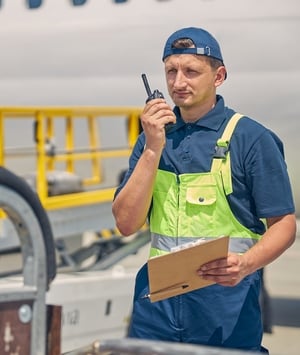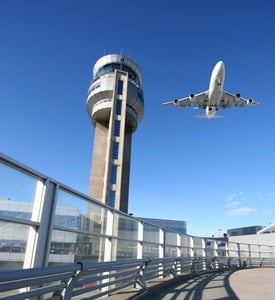What Are Safety Objectives in Aviation SMS

Safety objectives in aviation SMS are the markers your safety program uses to assess whether or not your safety goals are being achieved. Your safety objectives will be the basis for how you measure safety performance.
Creating safety objectives is one of the most important tasks for setting yourself up to make good safety decisions and to monitor the performance of the SMS.
Important elements to point out when discussing what safety objectives are in aviation SMS are:
- They are built in response to safety goals;
- They are reviewed and updated regularly;
- You will create your key performance indicators (KPIs), also called safety performance indicators (SPIs) in response to them; and
- They specific and measurable.
The last bullet point is where safety management is most likely to make either one of the following mistakes:
- Objectives are too vague, such as:
- “Improve management efficiency when managing issues”
- Objectives are not measurable:
- “Improve hazard reporting culture”
You need to create safety objectives that are clear, specific, and in sentence form. With well-written safety objectives, you will be better able to:
- Demonstrate to auditors how your objectives tie into safety goals and objectives; and
- Create and track proper key performance indicators.
Related Articles on Aviation SMS Goals and Objectives
- What Are Safety Objectives in Aviation SMS
- How to Shape Your Corporate Vision With Aviation Safety Goals and Objectives
- How to Maintain Monthly Aviation SMS Hazard Reporting Goals
Here’s how to create proper safety objectives in three steps.
1 – Create Safety Goals

Safety goals should set the vision of your company’s airline or airport SMS. Safety goals will establish the safety culture, as well as what safety management teams value. Because of all of these things, the wording and language used in your safety goals are extremely important. So, when it comes to developing your goals, here is a general workflow:
First, review important elements of safety risk management, safety assurance, safety promotion, and safety policy, such as things like:
- Reporting policies;
- Responsibilities of management and employees;
- Privacy and security of reported issues;
- Issue management time frames and style;
- Safety communication and sharing;
- Relationship between management and front-line employees;
- Safety meetings;
- And so on.
There are many more important elements of safety, but this list should give you an idea. Based on empirical evidence from hundreds of aviation service providers, the most common safety objectives focus on improving safety cultures. Review the above list again. Every one of these items is related directly or indirectly to safety culture. This is a great place to focus when you are struggling to come up with credible objectives.
Make a list of the most important elements of safety to your organization. Is it reporting? Responsiveness to meeting deadlines?
Second, ask questions about how your organization should approach each element in your list of important safety concerns. For example, this includes things such as:
- How will you ensure that all issues are processed through the SMS?
- How will you ensure non-punitive reporting?
- How will your organization facilitate safety meetings?
- How will safety data be communicated to employees?
Your answers to these questions make logical goals. Once this is done, simply review your list of goals to ensure that your list of goals:
- Is not missing anything important;
- Is measurable, meaningful, attainable, and relevant.
Related Articles on Aviation SMS Safety Culture
- What Is Safety Culture in the Aviation Industry?
- 5 Characteristics of Effective Aviation Safety Cultures - With Free Survey
- 5 Components of Safety Culture in Aviation SMS
Difference Between Safety Goals and Objectives
The difference between safety goals and safety objectives is that safety goals are:
- High-level, general areas of safety that your organization would like to reach;
- Updated infrequently, such as minor updates on a yearly basis; and
- Will touch on every level of your safety program, from risk management to safety promotion.
In contrast, safety objectives are:
- Low-level, specific areas of safety that your program would like to reach;
- Updated often, such as semi-annually or yearly, with major updates or overhauls (i.e., organizations will commonly have different objectives each year); and
- Each objective is in response to a specific, single goal.
A good way of understanding the relationship between safety goals and objectives is that a safety goal is a parent to multiple safety objective children.
2 - How Safety Objectives Are Created

Safety objectives are created in response to organizational safety goals and objectives. For example, you might have a safety goal of:
- “Develop a positive, non-punitive hazard reporting culture.”
Each safety goal may have multiple safety objectives that allow your organization to account for each goal. In the case of our example safety goal above, you could create several different objectives that help account for and measure the performance of that goal, such as:
- Increase hazard reporting by 10% over the previous year;
- Reduce average day for hazard reporting for new employees to less than 14 days; and
- Train at least 95% of employees on hazard identification.
These objectives will acutely help you understand whether or not your company is reaching that goal. These objectives are also specific and easily measurable. In the example above, the hazard identification training objective supports your goal of developing a positive, hazard reporting culture. This is a great example that you could easily use in your SMS. Hazard identification training could also be used for another goal to improve safety cultures.
Creating safety objectives is a matter of reviewing each safety goal, and creating one or more objectives to account for each goal. Some safety goals may have a handful of objectives, and some safety goals will only have one or two objectives. For a credible end result to present to auditors, aim for a list of safety objectives that are 2-3 times longer than your list of safety goals.
Note that I mentioned auditors. Yes, SMS auditors are keenly interested in SMS goals and objectives. This activity is one of the important elements for safety performance monitoring and measurement of SMS performance. Guess who else needs to be able to demonstrate that the organization is monitoring SMS performance? You are right, the accountable executives!
For every aviation SMS, accountable executives are responsible for:
- Ensuring SMS is implemented properly and performing as designed in all areas of the organization; and
- Regularly reviewing organizational safety performance and addressing substandard safety performance.
Consequently, you should make a point of involving the accountable executive and upper management in creating and reviewing SMS goals and objectives.
Related Articles on Aviation Hazard Identification
- 4 Pillars | What Is Hazard Identification in Aviation SMS
- 4 Tips to Approach Hazard Identification in Aviation SMS
- FAA Part 5 Compliance | Safety Risk Management Hazard Identification Requirement
3 - Updating Safety Objectives Yearly
As noted above, the performance of these objectives should be reviewed regularly. Based on reviewing goals and objectives from a couple of hundred operators, we see that most review their goals and objectives annually. This is not representative of all operators required to have an SMS. The operators we review are using an SMS database and not spreadsheets to manage their goals and objectives.
If you are using spreadsheets, you will be spending more time updating and reviewing safety objectives because spreadsheets cannot update themselves. An SMS database pulls data related to daily SMS activities performed by the employees. These activities may revolve around:
- hazard reporting;
- risk management activities;
- hazard analysis;
- monitoring risk control measures; or
- training and qualifications.
Since goals and objectives require data from multiple areas of the SMS, spreadsheets are not sustainable for tracking and generating reports in real time. The accountable executive and upper-level managers will be able to make more timely decisions regarding SMS performance when they can conveniently access performance reports.
As management reviews their safety objectives, managers may deem that the objective has been either satisfied or no longer relevant to organizational goals. In these cases, a new objective may replace it that still satisfies its parent goals or you may wish to concentrate on other more pressing goals.
This process of managing objectives helps safety teams monitor the continuous improvement of the SMS, which is an important element of the Safety Assurance pillar. It doesn’t make sense to retain an objective that has reached its attainable limit. When objectives reach their realistic limit, they should be replaced. Don't delete these objectives, as you may need to review them in the future, such as when SMS auditors come to visit.
As an example of retiring and replacing an objective consider that the "Train at least 95% of employees on hazard identification" objective is satisfied. The next year that objective may be replaced by, “Average end of hazard identification training assessment score is 70% or better.”
This new objective demonstrates continuous improvement for the parent goal of “Developing hazard reporting culture.” Moreover, reaching 95% of hazard identification training seems like an attainable limit. Reaching 100% may be both unrealistic and resource-intensive.
Creating and managing safety goals and objectives can be done using spreadsheets. In fact, most smaller operators use spreadsheets for this purpose, but they have problems easily retrieving historical data when spreadsheet data is either lost or deleted.
If you haven't realized this by now, an SMS database that automatically generates SMS performance charts and graphs is the best solution. Auditors are more impressed with objectives that are updated by a centralized database than a spreadsheet for the obvious reason: it is harder to fake database reports than with a spreadsheet. An SMS database is also more professional and audit-worthy.
Related Articles on Using Spreadsheets in Aviation SMS
- See How Spreadsheet Not EASA Compliant Aviation Hazard Reporting Database
- 5 Things Spreadsheets Can't Do for Your SMS
- Spreadsheets vs Software for Aviation Safety Management
Examples of Safety Objectives in Aviation Safety

Here is a list of potential objectives that will give you an idea of what kind of wording demonstrates specific and measurable.
- Increase hazard reporting by 10% over the previous year.
- Decrease average time for closing high-risk issues by 1 day over the previous year;
- Decrease number of internal audit findings by 1 over the previous year;
- Hold 50 safety meetings;
- Having average meeting attendance rate of 8;
- Increase the number of employees who have received all available training by 5%;
- Reduce the number of fatigue incidents by 20%;
- Increase average score of safety culture survey by 10%; and
- Increase the number of active control measures by 3%.
There are many more objectives beyond this, but hopefully, this list should give you a good idea of what specific and measurable looks like. You might compare the list above to less effective objectives, which are either NOT measurable or specific like:
- Improve non-punitive reporting policy;
- Update safety policies; and
- Improve risk management efficiency.
These safety objectives are vague and not measurable. They are also not as specific as the objective examples shown earlier.
Final Thoughts on Creating SMS Objectives
Goals and objectives are not to be taken lightly if you are expected to have a functioning SMS. Objectives should be tied closely to your key performance indicators (KPIs). You may know your KPIs as SPIs or "safety performance indicators." Regardless, objectives and KPIs are critical to monitor SMS health and performance.
Since the accountable executive relies on objectives and KPIs to demonstrate compliance to auditors, don't be cheap when trying to manage these important SMS elements. Your certificate depends on your ability to demonstrate SMS compliance.
Related Aviation SMS Database Articles
- What Is an Aviation Safety Database
- How to Choose the Best Aviation Safety Database Software
- How to Manage Aviation Safety Programs Without Complex SMS Databases
If you need tools to help create and manage your objectives, we can help.
SMS Demo Videos
Prefer to watch demo videos before a live demo? We recommend it.
For more information about quality objectives, see this list of leading indicators. Based on this list, you should easily be able to identify relevant elements of safety performance that you can use to create objectives.
Last updated September 2025.






